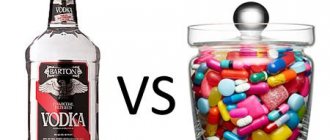Ambroxol and alcohol
The compatibility of Ambroxol and alcohol can cause lethargy, apathy, and fatigue.
Combining the drug with alcohol leads to gastrointestinal disorders and breathing problems. It is strongly not recommended to drink alcoholic beverages during treatment with tablets or syrup.
↑ Use search Are you having a problem? Need more information?
Type in the form and press Enter!
Having penetrated the stomach, ethyl alcohol spreads through the bloodstream throughout the body. In the respiratory tract it enters into complex biochemical reactions with the active ingredient.
The result is the leveling of the pharmacological properties of the latter. The drug does not have any therapeutic effect, does not eliminate a dry, debilitating cough, sore throat, or breathing problems.
There have been cases of increased side effects of the drug under the negative influence of alcohol. Their simultaneous use provoked the development of allergic reactions of a local or systemic nature. As a result, it was necessary to treat not only respiratory infections, but also get rid of skin rashes, shortness of breath, and diarrhea.
Brief characteristics of the drug
This is a representative of the clinical-pharmacological group of mucolytics. Its active substance stimulates the liquefaction of bronchial secretions and its detachment from the walls of the respiratory tract. It is easily eliminated from the body with each cough. The mucolytic agent is available in two dosage forms - tablets and syrup.
Doctors prescribe them for adults and children with the following pathologies:
- chronic obstructive pulmonary disease;
- chronic and acute bronchitis, tracheobronchitis;
- bronchiectasis;
- cystic fibrosis;
- pneumonia;
- bronchial asthma with difficult sputum discharge.
If the dosage regimen is followed, the medicine is well tolerated, does not cause addiction, does not cause “withdrawal syndrome”, and does not interfere with the functioning of internal organs. It has a therapeutic effect 30-40 minutes after using the tablets or syrup.
Use of the drug for alcoholism
The medicine is not used directly in the treatment of chronic alcoholism. Its components cannot cope with the strong, painful addiction to alcohol.
If a person drinks alcoholic beverages daily, then mucolytic is contraindicated for him for the following reasons:
- There will be an excessive pharmacological load on the body, because the drug will still not have a therapeutic effect.
- The consequences of such treatment will be digestive disorders, drowsiness, and lethargy.
In people with alcohol dependence, toxic ethanol products constantly circulate in the systemic bloodstream. Therefore, reception is possible only at the stage of complete abstinence from alcohol.
Patients with chronic alcoholism suffer from many pathologies due to a persistent decrease in immunity, including respiratory immunity. The use of a mucolytic in complex therapy will come in handy.
Using the drug for a hangover
The drug is useless in eliminating the consequences of evening alcohol abuse. It does not eliminate headaches and stomach pains, tremor of the fingers, or nausea rising in the throat. The drug cannot even cope with shortness of breath or the feeling of lack of air when inhaling.
If a person with tracheitis, bronchitis, sore throat, or sinusitis suffers from a hangover, then taking syrup or tablets is allowed after the breakdown products of ethanol are removed from the body. Otherwise, the symptoms of withdrawal syndrome will only intensify, and the progression of the disease will accelerate.
Consequences of drinking alcohol
Ethyl alcohol neutralizes all the beneficial effects of the mucolytic. To speed up recovery, a person is forced to take tablets or syrup in large quantities.
And this is fraught with a dangerous overdose, which is manifested by the following symptoms:
- surges in blood pressure with its subsequent decrease to values dangerous to health and life;
- diarrhea or constipation;
- lack of appetite, excessive gas formation, heartburn;
- attacks of nausea, often ending in vomiting;
- headaches similar to migraines;
- weakness, drowsiness, apathy;
- pain in the epigastric region and lower abdomen.
These symptoms occur when combined with alcohol, indicating the development of systemic adverse reactions. Local negative effects occur less frequently - itching, soreness, blisters with liquid contents, swelling and irritation of the epidermis.
When can you take the drug, after how long
After drinking alcohol, at least 8 hours must pass so that taking the medicine does not lead to a deterioration in the person’s well-being. Doctors recommend that women wait 10 hours, since metabolic processes in their bodies proceed a little slower.
During a course of treatment, it is advisable to give up alcohol altogether. The ingredients constantly circulate in the bloodstream, so the likelihood of their interaction with ethanol is high.
When can you drink alcohol if you are taking or have taken the drug?
How long after you can drink alcohol after taking a tablet or syrup - after 5-6 hours. This is how long it takes the liver to break down the components of the drug, and the kidneys to evacuate the metabolites.
Treatment should be resumed using the drug at a reduced dosage, and then increase it to the one recommended in the instructions.
Ambroxol and beer
There is no compatibility between beer and a mucolytic drug. Due to the presence of carbon dioxide bubbles in the drink, the drug components penetrate into the blood immediately, and not gradually. And this significantly increases the risk of overdose, the simultaneous manifestation of all side effects.
The foamy drink is incompatible with all drugs that are intended for the treatment of viral, bacterial, and fungal infections of the respiratory tract.
Ambroxol during pregnancy
During pregnancy , the drug is contraindicated only in the first trimester. In the second and third trimesters, it is allowed to be prescribed, taking into account the benefits for the expectant mother and the potential risks for the developing fetus.
On forums, many are interested in why doctors recommend this particular drug during pregnancy. There is evidence that in cases where a woman takes tablets or syrup during pregnancy , the synthesis of pulmonary surfactant .
Interesting results were noted when using the drug in the treatment of respiratory system in unborn children. The ability of the drug to pass well through the placental barrier allows it to be used in cases where the child, for one reason or another, begins to accumulate mucus in the bronchi or lungs .
If treatment with the drug is necessary during breastfeeding , the issue of stopping the latter should be decided, since the active substance Ambroxol is excreted in milk.
Organs affected by the toxin
The combined use of pharmacological agents and alcohol has a toxic effect on the internal organs and environments of the body. Alcohol, entering into a chemical reaction with a medicine, leads to poisoning, disrupts physiological processes, enhances or weakens the healing properties of drugs.
The liver suffers more than other organs. She gets hit twice. Many medications have a side effect - hepatotoxicity, destroy cells, and disrupt the physiology of the organ. In the liver, alcohol breaks down to ethanal, a substance 20-30 times more toxic than ethanol, which causes the death of hepatocytes.
Dangerous groups of drugs for the organ in combination with alcohol:
- anti-inflammatory;
- hormonal;
- antibacterial;
- antifungal;
- glucose control agents for diabetes mellitus;
- anti-tuberculosis;
- cytostatics (chemotherapy drugs);
- tranquilizers (anti-epileptic, psychotropic).
In second place among the internal organs exposed to the harmful effects of alcohol together with medications are the heart and vascular system. Strong drinks during drug therapy constrict blood vessels and increase blood pressure. The simultaneous intake of alcohol and chemical substances leads to failure of the myocardium and increases the risk of developing an attack of angina pectoris and a heart attack.
A mixture of ethanol and pharmaceuticals disrupts the quality of the blood and reduces clotting. This is dangerous due to internal bleeding and strokes.
Rules for taking medications and alcohol
Drinking alcohol during treatment minimizes the clinical effect of therapy and creates a risk of developing complications of the disease.
If this cannot be avoided, follow the rules of behavior that will reduce the occurrence of negative consequences:
- Do not drink strong drinks (vodka, cognac, whiskey), choose dry wine (100-150 ml), beer (no more than 300 ml). Don't drink alcohol on an empty stomach.
- The interval between taking the medicine and alcohol should be at least 2 hours.
- To reduce the toxic effect, take medications that protect the liver (hepatoprotectors), pancreas (pancreatin), and stomach (antacids ─ Rennie, Almagel).
If a person takes antiviral medications for colds, anti-inflammatory drugs, alcohol in moderation does not pose a threat to the body.
Alcoholic drinks during treatment are strictly contraindicated in cases of liver cirrhosis, severe infectious diseases, and during a course of chemotherapy.
Medicines, alcohol and chronic diseases
If a person has chronic diseases, simultaneous use of alcohol and medications is potentially dangerous for the functioning of vital organs. Since patients systematically take prescribed medications, the influence of alcohol can lead to negative consequences.
People with chronic heart disease (angina pectoris, heart defects) develop arrhythmias of varying severity. Heart attacks with severe pain syndrome develop, which is not relieved by Nitroglycerin, and the risk of developing myocardial infarction increases significantly.
In case of chronic liver diseases (viral hepatitis, hepatosis), alcohol during treatment can become a trigger in the development of cirrhosis and hepatocellular carcinoma (cancer).
Drinking alcohol during cirrhosis leads to the following consequences:
- bleeding into the abdominal cavity;
- liver decomposition, infection, peritonitis;
- hepatic coma;
- death.
If a person is on long-term treatment with sedatives, psychotropic drugs, tranquilizers, he is contraindicated in drinking alcohol. This leads to severe depression and the appearance of obsessive states (hallucinations, phobias). Suicidal feelings develop. Such a patient needs constant monitoring and assistance from a psychiatrist.
The most dangerous combinations and consequences
The combination of alcohol and chemical-based drugs can lead to serious disorders in the body, and in some cases to fatal consequences.
List of medications and their side effects in combination with alcohol:
| Name of group, drug | Negative results of interaction |
| Neuroleptics (tranquilizers, anticonvulsants, hypnotics) | Severe intoxication, up to cerebral coma |
| CNS stimulants (Theophedrine, Ephedrine, Caffeine) | Rapid increase in blood pressure, hypertensive crisis |
| Antihypertensives (Captofrin, Enalapril, Enap-N), diuretics (Indapamide, Furosemide) | Sudden drop in pressure, collapse |
| Analgesics, anti-inflammatory | Increased toxic substances in the blood, general poisoning of the body |
| Acetylsalicylic acid (Aspirin) | Acute gastritis, perforation of gastric ulcer and 12-PC |
| Paracetamol | Toxic liver damage |
| Hypoglycemic (Glibenclamide, Glipizide, Metformin, Phenformin), insulin | A sharp decrease in blood sugar levels, hypoglycemic coma |
pharmachologic effect
Mucolytic and expectorant, is the active N-demethylated metabolite of bromhexine. It has secretomotor, secretolytic and expectorant effects. Stimulates the serous cells of the bronchial mucosa, increases the motor activity of the ciliated epithelium by affecting type 2 pneumocytes in the alveoli and Clara cells in the bronchioles, enhances the formation of endogenous surfactant - a surfactant that ensures the sliding of bronchial secretions in the lumen of the respiratory tract.
Ambroxol increases the proportion of the serous component in the bronchial secretion, improving its structure and helping to reduce viscosity and thin the sputum; as a result, mucociliary transport improves and the removal of sputum from the bronchial tree is facilitated.
When ambroxol is taken orally, the effect, on average, occurs after 30 minutes and lasts 6-12 hours, depending on the single dose.
Interaction
The use of Ambroxol in combination with antibiotics helps to increase the concentration of the active substance of the latter in the bronchial mucosa and pulmonary alveoli , which in turn improves the clinical situation with bacterial infections of the lungs .
The combination of a drug with antibiotics of an antibiotic alone , even in cases where the effectiveness of an antibacterial drug .
Ambroxol enhances the effect of Ampicillin , Amoxicillin , and Theophyllinum and promotes their better penetration into bronchial secretions .
No antagonistic interactions of the drug with diuretics and cardiac glycosides .
The use of Ambroxol with drugs that suppress the cough reflex significantly complicates the discharge of sputum while reducing the intensity of the cough .
The drug is compatible with drugs that are used to slow down labor.
Pharmacokinetics
After oral administration, ambroxol is quickly and almost completely absorbed. Tmax is 1-3 hours. Plasma protein binding is approximately 85%. Penetrates the placental barrier and is excreted in breast milk. Metabolized in the liver to form metabolites (dibromanthranilic acid, glucuronic conjugates), which are excreted by the kidneys. It is excreted primarily by the kidneys - 90% in the form of metabolites, less than 10% unchanged. T1/2 from plasma is 7-12 hours. T1/2 of ambroxol and its metabolites is approximately 22 hours.
Due to high protein binding and large Vd, as well as slow re-penetration from tissues into the blood, significant elimination of ambroxol does not occur during dialysis or forced diuresis. The clearance of ambroxol in patients with severe liver failure is reduced by 20-40%. In severe renal failure, T1/2 of ambroxol metabolites increases.
Ambroxol price
The average price of Ambroxol in tablet form in Ukraine is 3.8 UAH. The price of Ambroxol syrup is from 11 to 75 UAH (depending on the manufacturer). The cost of the inhalation and oral solution also varies depending on which pharmaceutical company makes it.
The average price of Ambroxol tablets in Russia is 20 rubles; syrup for children can be purchased for an average of 30-50 rubles per bottle.
- Online pharmacies in RussiaRussia
- Online pharmacies in UkraineUkraine
- Online pharmacies in KazakhstanKazakhstan
ZdravCity
- Codelac Broncho + ambroxol 20 mg, tablets 10 pcs. JSC Pharmstandard (ICN) Leksredstva Kursk
139 rub. order - Ambroxol solution for internal use. approx. and ing 7.5mg/ml 100mlOzon LLC
RUB 131 order
- Ambroxol tablets 30 mg 30 pcs. JSC ALSI Pharma
43 RUR order
- Ambroxol-Hemofarm syrup 15mg/5ml 100mlHemofarm A.D. Vršac, branch Production site Šabac
94 RUR order
- Codelac Broncho + ambroxol 20 mg, tablets 20 pcs. JSC Pharmstandard (ICN) Leksredstva Kursk
170 rub. order
Pharmacy Dialogue
- Ambroxol (tab. 30 mg No. 20)Update of PFC CJSC
118 RUR order
- Ambroxol Welfarm (tab. 30 mg No. 30) Welfarm LLC
128 rub. order
- Ambroxol (syrup 15mg/5ml 100ml)Hemofarm
89 rub. order
- Ambroxol (tab. 30 mg No. 20) Ozone LLC
32 RUR order
- Ambroxol-ALSI (tab. 30 mg No. 30) Alsi Pharm
44 RUR order
show more
Pharmacy24
- Ambroxol 30 mg tablets PrAT" Pharmaceutical company "Darnitsa", Ukraine
11 UAH. order - Ambroxol syrup 30 mg/5 ml 100 ml PAT NEC "Borshchagivsky chemical and pharmaceutical plant", Kiev, Ukraine
27 UAH order
- Ambroxol 30 mg No. 20 tablets Ternopharm TOV, Ternopil, Ukraine
7 UAH order
- Ambroxol 0.03 g No. 20 tablets PAT NEC "Borshchagivsky chemical and pharmaceutical plant", Kiev, Ukraine
7 UAH order
- Ambroxol 0.03 g No. 20 tablets PAT "Khimpharmzavod" Chervona Zirka", Kharkov, Ukraine
8 UAH order
PaniPharmacy
- Ambroxol liquid Ambroxol forte syrup 30mg/5ml 100ml Ukraine, Zdorovye LLC
31 UAH order
- Ambroxol liquid Ambroxol syrup 15mg/5ml 100ml Ukraine, Borshchagovsky Chemical Plant PJSC
27 UAH order
- Ambroxol tablets Ambroxol tablets. 0.03g No. 20 Ukraine, Lekhim-Kharkov CJSC
8 UAH order
- Ambroxol liquid Ambroxol syrup 15mg/5ml 100ml Ukraine, Ternopharm LLC
23 UAH order
- Ambroxol tablets Ambroxol tablets. 0.03g No. 20 Ukraine, Kiev Vitamin Plant PJSC
12 UAH order
show more
Indications of the active substances of the drug Ambroxol-BV
For oral administration
Diseases of the respiratory tract, accompanied by the release of viscous sputum and difficulty in sputum discharge: acute and chronic bronchitis; pneumonia; bronchial asthma; bronchiectasis; COPD
For intravenous administration
Diseases of the respiratory tract with the release of viscous sputum and difficulty in sputum discharge in cases where it is necessary to obtain a rapid therapeutic effect or it is impossible to take the drug orally: acute and chronic bronchitis; pneumonia; bronchial asthma; bronchiectasis; stimulation of surfactant synthesis during respiratory distress syndrome in premature infants and newborns (as part of complex therapy).
Indications for use: what are Ambroxol tablets for and what is Ambroxol in syrup form for?
It is known that the viscosity, elasticity and adhesiveness of sputum determine how easily it is separated and expectorated.
Therefore, mucolytic drugs are especially useful for diseases of the respiratory system , conditions that are accompanied by the formation and accumulation in the bronchi and lungs of viscous, poorly separated mucous or purulent-mucous sputum .
Indications for use of Ambroxol are:
- obstructive bronchitis (in acute and chronic forms);
- pneumonia;
- tracheitis;
- constrictive bronchiolitis;
- laryngitis;
- rhinitis;
- cystic fibrosis;
- bronchial asthma;
- pharyngitis;
- atelectasis , developed as a result of mucoid blockage of the bronchi , in patients with a tracheostomy tube , etc.;
- respiratory distress syndrome (shock lung) in adults;
- respiratory distress syndrome (RDS) in newborn infants (including children born prematurely) and other diseases associated with impaired bronchial secretion and accompanied by increased formation of viscous mucus.
Dosage regimen
The method of administration and dosage regimen of a particular drug depend on its release form and other factors. The optimal dosage regimen is determined by the doctor. The compliance of the dosage form of a particular drug with the indications for use and dosage regimen should be strictly observed.
The duration of treatment is determined by the doctor individually and depends on the severity of the disease. If it is necessary to use the drug for more than 4-5 days, consult a doctor.
For oral administration, the dose is set individually and depends on the age of the patient and the dosage form used.
When administered intravenously to adults - 45 mg/day, 2-3 times/day in divided doses; in severe cases, the dose can be increased to 60-90 mg/day, 2-3 times/day in divided doses; for children, the daily dose is usually 1.2-1.6 mg/kg 2-3 times/day in divided doses.
For respiratory distress syndrome in newborns and premature infants, the daily dose is 30 mg and is usually divided into 4 separate administrations.
Treatment of children under 2 years of age should be carried out only under the supervision of a physician.
Parenteral use is stopped after the disappearance of acute manifestations of the disease and switched to taking abmroxol orally in appropriate dosage forms.
Ambroxol for children
The most common childhood diseases are diseases of the bronchi and lungs , which are usually accompanied by stagnation of sputum in the bronchi . Timely excretion of sputum is an indispensable condition for the normal functioning of the respiratory system , as well as the key to their recovery from diseases.
Ambroxol syrup for children is one of the latest developments in the field of pharmacy. Like other dosage forms of Ambroxol, the drug has proven itself to be an effective remedy for sputum , so pediatricians recommend it for the treatment of even very young patients.
The dose and dosage form of the drug for children is selected depending on age (the dose varies from 15 mg to 45 mg per day).
Side effect
Allergic reactions: rarely - skin rash, urticaria, exanthema, facial swelling, shortness of breath, itching, fever; frequency unknown - anaphylactic reactions, including anaphylactic shock, angioedema, itching, allergic contact dermatitis.
From the digestive system: often - nausea; uncommon - vomiting, diarrhea, dyspepsia, abdominal pain.
From the nervous system: often - dysgeusia.
From the skin and subcutaneous tissues: very rarely - toxic epidermal necrolysis (Lyell's syndrome), Stevens-Johnson syndrome; frequency unknown - acute generalized eczematous pustulosis.
Contraindications for use
Hypersensitivity to ambroxol or auxiliary components of the drugs; I trimester of pregnancy; lactation period (breastfeeding); children under 6 years of age (for tablets); children under 12 years of age (for long-acting dosage forms).
Carefully
Impaired bronchial motility and increased mucus secretion (for example, with rare immotile cilia syndrome); renal failure and/or severe liver failure; peptic ulcer of the stomach and duodenum (including a history); II and III trimesters of pregnancy; children under 2 years of age (oral solution; only as prescribed by a doctor).
Reviews about Ambroxol
The drug Ambroxol is a very popular drug that allows you to effectively treat respiratory diseases . It normalizes the functioning of bronchial cilia , thins accumulated mucus and activates its elimination.
The use of an inhalation solution, injection solution, syrup or Ambroxol tablets - reviews are proof of this - enhances the formation of an agent that clears mucus from the bronchi and lungs, and also prolongs its action.
Reviews of Ambroxol syrup indicate that this drug has virtually no drawbacks. It effectively eliminates unpleasant symptoms of the disease, relieves inflammation and stimulates the synthesis of immunoglobulin , which in turn helps strengthen local immunity.
Another advantage of the drug is its price - both tablets and syrup for children belong to the category of inexpensive medicines.
Use for renal impairment
Use with caution in case of renal failure.
Directions for use and doses
Unless otherwise prescribed, it is recommended:
Children:
up to 2 years: 2.5 ml (1/2 dosage spoon) 2 times a day, which is equivalent to 15 mg of ambroxol per day;
from 2 to 6 years: 2.5 ml (1/2 dosage spoon) 3 times a day, which is equivalent to 22.5 mg of ambroxol per day;
from 6 to 12 years: 5 ml (1 dosage spoon) 2-3 times a day, which is equivalent to 30-45 mg of ambroxol per day.
Adults and children over 12 years of age: 10 ml (2 dosage spoons) 3 times a day, which is equivalent to 90 mg of ambroxol per day.
The drug can be taken regardless of meals. Eating does not affect the effectiveness of the drug.
In case of acute illnesses, you should consult a doctor if symptoms do not disappear and/or intensify despite taking the drug.
The duration of treatment is determined by the attending physician.
It is necessary to consult a doctor before using the drug for children under 2 years of age.
Drug interactions
The use of ambroxol together with antibiotics (amoxicillin, cefuroxime, erythromycin, doxycycline) increases the concentration of antibiotics in lung tissues.
The use of ambroxol hydrochloride with antitussive drugs leads to suppression of sputum production and excessive accumulation of mucus with a decrease in cough. Therefore, such a combination is possible only after a careful assessment by the doctor of the ratio of expected benefits and possible risks of use.
Compound
Ambroxol tablets contain 30 mg of ambroxol hydrochloride as an active component and excipients: lactose monohydrate , corn starch (Amylum maidis), microcrystalline cellulose (Cellulose microcristallic), stearate (Magnesium stearate), dioxide silicon (Silicii dioxydum).
5 ml of Ambroxol syrup contains 15 mg of ambroxol hydrochloride and a number of other ingredients: sodium benzoate (E211, Sodium benzoate), propylene glycol, glycerin (Glycerinum), sodium saccharin (Saccharin sodium), sorbitol (E420 ; Sorbitol), hydroxyethylcellulose (Hydroxyethylcellulose), citric acid monohydrate (Citric acid monohydrate), flavors (apricot, raspberry, orange), menthol (Mentholum), purified water (Aquae purificati).
Cautions, therapy monitoring
Isolated cases of severe skin lesions such as Stevens-Johnson syndrome and Lyell's syndrome (toxic epidermal necrolysis) have been reported with the use of mucolytic agents such as ambroxol hydrochloride. They could mainly be explained by the severity of the underlying disease and/or concomitant therapy. In addition, at the initial stage of Stevens-Johnson syndrome or Lyell's syndrome, patients may experience flu-like nonspecific prodromal symptoms, such as fever, body pain (aches), rhinitis, cough, sore throat. As a result of their misjudgment, patients may have received medications for the symptomatic treatment of coughs and colds. For this reason, if skin and/or mucous membrane lesions appear when using Ambroxol 15, you should immediately stop taking the drug and seek medical help. The drug should be used with caution in patients with gastric and/or duodenal ulcers. In case of impaired renal function or severe liver disease, Ambroxol 15 should be used only after consulting a doctor; it is possible to lengthen the intervals between doses or reduce the dose of the drug.
Ambroxol hydrochloride is metabolized in the liver and excreted from the body by the kidneys, therefore, in severe renal failure, accumulation of ambroxol and/or its metabolites in the liver is possible. During treatment, it is necessary to consume enough liquid (juices, tea, water) to enhance the mucolytic effect of the drug. The drug contains sorbitol. Patients with rare hereditary problems of fructose intolerance should not take this drug. Sorbitol may also cause a mild laxative effect.
Ambroxol 15 does not contain sugar, so it can be used by patients with diabetes. Does not contain alcohol. Ambroxol 15 with antitussive drugs leads to impaired sputum discharge while reducing cough. With increased secretion of mucus, with impaired bronchomotor functions (for example, with such a rare genetically determined disease as primary ciliary dyskinesia), mucolytic agents (including ambroxol) should be used with caution due to the risk of possible accumulation of large amounts of mucus. It is necessary to consult a doctor before using the drug in children under 2 years of age.
Overdose
At this time, specific symptoms of ambroxol overdose are unknown. In case of accidental overdose and/or erroneous use, symptoms consistent with the side effects of ambroxol hydrochloride may be observed.
Treatment is symptomatic.
special instructions
Since Ambroxol tablets contain lactose, patients with rare hereditary galactose intolerance, Lapp lactose deficiency or glucose-galactose malabsorption should not take this drug. When prescribing Ambroxol to patients with impaired renal function and/or severe liver disease, careful medical supervision is required. In such cases, it is recommended to reduce the dose and/or increase the time between doses.
Use during pregnancy and lactation
Ambroxol is contraindicated in the first trimester of pregnancy. The use of Ambroxol in the second or third trimester of pregnancy is possible only after a preliminary assessment of the ratio of the expected benefit to the mother and the possible risk to the fetus. Ambroxol is excreted into breast milk and is therefore contraindicated for use during breastfeeding.
Features of the effect of the drug on the ability to drive a vehicle or potentially dangerous mechanisms
Analogs
Level 4 ATX code matches:
Mukolik
Abrol
Ambrosan
Bronchorus
ACC 100
ACC 200
ACC Long
ACC
Mukolwan
Lazolvan
Bromhexine 8
Bromhexine 8 Berlin-Chemie
Bromhexine
Bronchobos
Carbocisteine
Erdomed
Pulmozyme
Pectolvan C
Halixol
Ambrobene
Analogues of Ambroxol are the drugs Ambrobene , Ambrohexal , Ambroxol-Vial , Ambroxol-Zdorovye , Ambroxol-Vishfa , Ambroxol-Darnitsa , Lazolvan , , Bronkhoxol , Neo-Bronchol , Halixol , Medox , etc.
Which is better: Ambroxol or Bromhexine? What are these pills for?
The active ingredient Ambroxol is an active metabolite of bromhexine hydrochloride (a substance that is a synthetic analogue of the alkaloid vasicine ). At the same time, the therapeutic effectiveness of Ambroxol is an order of magnitude higher than that of its predecessor.
In addition, Ambroxol is better tolerated by patients, has virtually no contraindications (even infants and pregnant women can take it), and side effects from its use develop extremely rarely.
Use of the drug for alcoholism
The medicine is not used directly in the treatment of chronic alcoholism. Its components cannot cope with the strong, painful addiction to alcohol.
If a person drinks alcoholic beverages daily, then mucolytic is contraindicated for him for the following reasons:
- There will be an excessive pharmacological load on the body, because the drug will still not have a therapeutic effect.
- The consequences of such treatment will be digestive disorders, drowsiness, and lethargy.
In people with alcohol dependence, toxic ethanol products constantly circulate in the systemic bloodstream. Therefore, reception is possible only at the stage of complete abstinence from alcohol.
Patients with chronic alcoholism suffer from many pathologies due to a persistent decrease in immunity, including respiratory immunity. The use of a mucolytic in complex therapy will come in handy.
Sources
- https://lechimbolez.ru/ambroksol-i-alkogol-mozhno.html
- https://MyWeak.ru/alkogolizm/lekarstva/ambroksol-sovmestimost.html
- https://www.VIDAL.ru/drugs/ambroxol-bv
- https://drugs.medelement.com/drug/%D0%B0%D0%BC%D0%B1%D1%80%D0%BE%D0%BA%D1%81%D0%BE%D0%BB-15 -%D0%B8%D0%BD%D1%81%D1%82%D1%80%D1%83%D0%BA%D1%86%D0%B8%D1%8F/867150351605181836?instruction_lang=RU
- https://bz.medvestnik.ru/drugs/1402.html
- https://drugs.medelement.com/drug/%D0%B0%D0%BC%D0%B1%D1%80%D0%BE%D0%BA%D1%81%D0%BE%D0%BB-30 %D0%BC%D0%B3-%D0%B8%D0%BD%D1%81%D1%82%D1%80%D1%83%D0%BA%D1%86%D0%B8%D1%8F/ 184241071477650943?instruction_lang=RU
[collapse]








